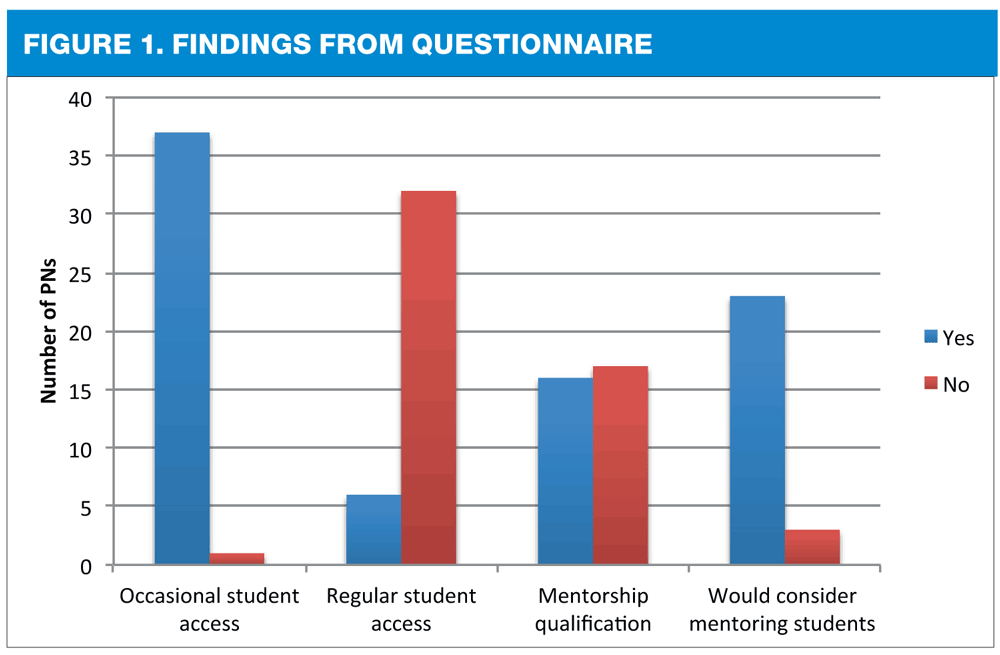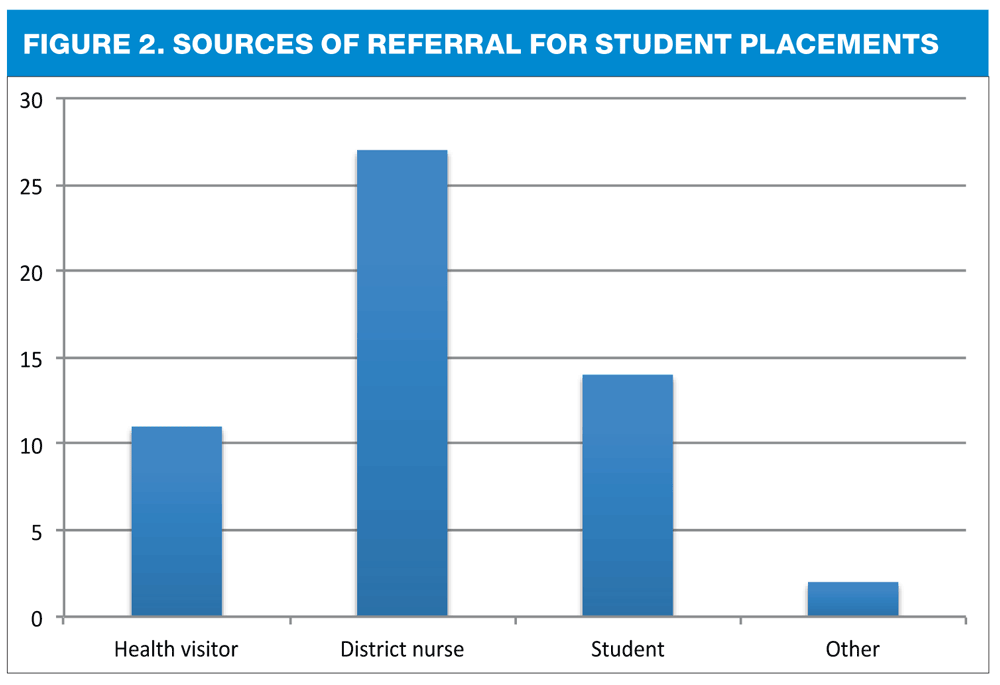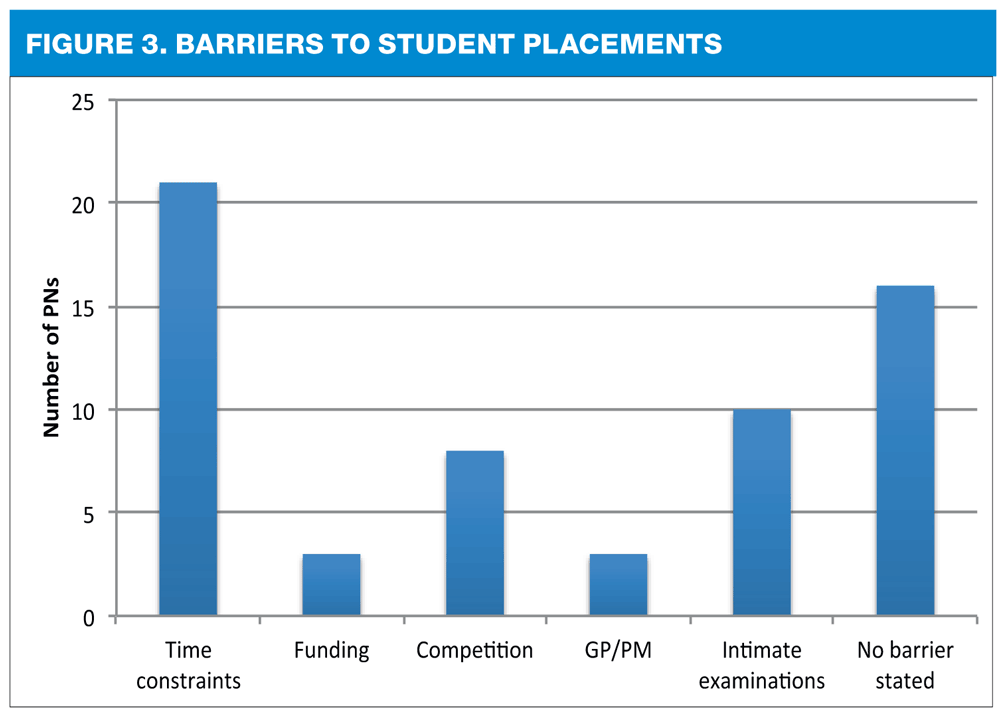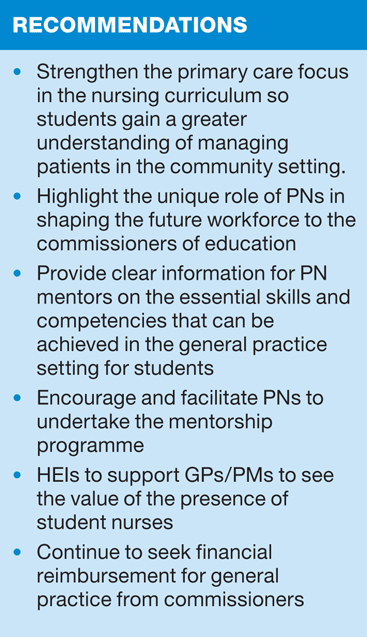A framework for placing students in general practice
Marie Therese Massey
Marie Therese Massey
MEd, V300, PGDip Medical Education, ENB 901/8103, BMed Sci (GPN), RSCN, RGN
Specialist Practice Nurse Sexual Health, Senior Lecturer, Sheffield
Newly registered nurses need to emerge from training with the knowledge and skills to cope with complex and disparate cases in the community: practice nurses could be essential partners in shaping this future community workforce
The Willis report on nursing education last year recommended that 'positive practice environments should be increased in community settings for student nurses and medical general practice should not be exempt from this'.1 The recommendation recognises the increasing trend for services to migrate from the secondary sector to primary care,2 and the providers of nursing education need to reflect this in both the undergraduate nursing curriculum and the clinical placement area. However, while it is widely recognised that the general practice setting provides a rich learning environment for students,3 placing them in general practice continues to be a challenge for Higher Education Institutions (HEIs).
Learning in the clinical environment continues to be a crucial element of the adult nursing curriculum and accounts for 50% of pre-registration nursing education; however the majority of student placements occur in the acute setting where the clinical environment and clinical experience differs from that in primary care. If HEIs are to produce new registrants that are fit for practice in all health care settings then every field of the community nursing service has to be explored.4
The value of placing students in general practice is gaining momentum nationally and the picture at a local level is that the number of students being allocated placements in general practice has increased but, in the main, adult nursing students undergoing a placement in the community are mentored by district nurses, community nurses and health visitors. However, there is anecdotal evidence that students do spend time with practice nurses during their community placement. The aim of this small study was to determine the extent to which practice nurses (PNs), in a city in the north of England, were informally facilitating students' learning in clinical practice. Data on the PN experiences were gathered and the effect of the presence of student nurses on nursing culture was investigated.
METHOD
A mixed method research design was employed. Data were collected from PNs between June and July 2012, initially from self-completed questionnaires, followed by semi-structured interviews with a sub-sample of participants. A qualitative interpretive framework was was utilised to analyse the data. Themes were identified and subjected to thematic analysis.
RESULTS
The initial questionnaire was completed by 38 practice nurses, representing approximately 15% of the local workforce, but comprising nurses from 40% of local general practices. Of the 38 respondents, six participated in the semi-structured interviews.
All the study participants were female, with a mean age of 49. Only five of the participants under the age of 40. Nearly all (94%) worked in teams of between 3-5 nurses and 50% of participants were nurse prescribers. An unexpected finding was that 44% had undertaken a mentorship course in the past.
From the questionnaires it was clear that the participants were allowing students to take part in a variety clinical sessions, but only a small number of PNs were doing so regularly and for more than the occasional clinic (Figure 1). The most common model of student access was via an informal request from the students' mentor; however, some PNs were contacted directly by the student (Figure 2). Students would attend and observe clinics with varied opportunities to practise their clinical skills but we identified a number of barriers that restricted access for students (Figure 3).
Four themes were identified from analysis of the data from the interviews
- Time constraints
- Competing interests and remuneration
- The effect of being observed on the participants' nursing practice
- The value of the general practice settings for students
TIME CONSTRAINTS
An overwhelming majority (73%) found the experience to be positive but not without its challenges. Time was clearly an issue for most participants and it is probably worth remembering that most PNs in the study were allowing students to spend time with them on an informal basis and often as a gesture of goodwill to their community nursing colleagues. Consequently they would not have been allocated the extra time afforded to 'official' mentors.
'Past experience of having students proves clinics run late, as the time spent explaining to students can be lengthy as each experience is very different'
'Clinics run a lot slower with a student present'
'There is a key issue around time and having enough time after consultations to explain things fully.'
'Time would be my main concern. It is difficult to stay on schedule when you have a student visiting"¦ it would be challenging to get a practice manager to agree to double time slots'
FUNDING
When questioned on the perceived barriers to having student nurses on a regular basis, the nature of general practice as a 'business' and the attitude of the GP and practice manager clearly influenced the ease with which PNs accepted informal requests to accept student nurses. The issue of remuneration for mentoring students was raised more than once, as that lack of funding for student nurses was in sharp contrast to the situation with medical students in general practice, for whom funding is received. It seems ironic that the same PNs who struggle to give their time to student nurses are required to support the clinical education of medical students. Past experiences of having students also played a part. Not all students had given a good impression, and this influenced the PN's response to future requests.
'The main barrier is "competing" with medical students for whom we get paid'
'The only barrier was the GP's reluctance due to not receiving any payment'
'I would have to get GP agreement'
'It is unlikely that the practice would allow time for the training of students without some reimbursement'
'I suspect the GPs and practice manager would want funding and reassurance'
'My experience of having students is both good and bad: if they interact well both with me and the patient it's good [but] often they haven't seemed interested'
NURSES' PERCEPTIONS
Findings from the interviews indicated that there was the perception amongst the participants that the students did not have a clear understanding about the place of PNs as part of the multi disciplinary community team and their role in delivering holistic care. Nevertheless, the findings indicated that PNs were keen for students to share one of the unique characteristics of practice nursing — that of the one to one consultation between nurse and patient. With many of the nurses in the study being independent nurse prescribers there was the opportunity for students to observe the autonomous nature of PNs at its highest level.
Despite the time constraints PNs indicated that allowing students to participate in their clinics was a positive experience encouraging them to question their clinical practice. The desire to play a wider role in supporting student nurses was indicated by many of the participants.
'Good. I've enjoyed having students sit with me — they are often very interesting and it's good to have someone asking your opinions or [about] ways of doing things. I've found this means I question my practice and make certain I have a good evidence base for my actions so I can be clear with my explanations to aid their learning'
'It is good to get the students to see that there is a world outside secondary care... to show them that not only is practice nursing a possible career choice, it doesn't have to be at the end of their career.'
'Practice nursing is quite different from community nursing, and the knowledge and expertise and clinical skills of practice nursing are quite different. The student gains lot in terms of seeing nurses work independently and making decisions on patient care'
'I think they should be attached to practices for a period of time and get to see and understand the multidisciplinary team-working that is essential to modern general practice'
DISCUSSION
This study only explored the situation in one locality, and it would be interesting to investigate whether PNs are providing the same level of informal student support nationally. If it transpires that this model is duplicated throughout the country then PNs would be making a significant but unrecognised, and currently unsupported, contribution to nursing education. There is huge pressure on the HEIs to provide placements where the students learn to care in real-life settings in order to enhance employability and promote non-traditional environments as post qualification career alternatives.4,5 Across the UK nurses aged 50 plus are concentrated in key and growing sectors of the health workforce such as primary and community care,6 and an RCN survey of practice nurses across eastern England revealed 98% of all nurses working in GP surgeries are over the age of 40.7 While there is no immediate cause for alarm, GPs and Clinical Commissioning Groups need to prioritise planning for a future nursing workforce. One of the obvious solutions would be to collaborate with placement providers in order to nurture general practice nursing as a viable career pathway for new registrants. However, the need to increase general practice placements must be accompanied by close communication between the placement practice and the HEI, and there is a considerable amount of work to be undertaken if both PN and student are to benefit from the experience.
Practice nurses can provide a unique learning experience for students and are well placed to foster a positive attitude towards working in primary care. While official placements in general practice are increasing nationally, they are still comparatively few and far between. If the situation is to be improved then PNs need to be equipped with the knowledge and skills to become successful mentors, supported by their employers and local education providers.
REFERENCES
1. Willis Commission on Nursing. Quality with compassion: the future of nursing education. Executive summary; 2012. Available at: http://www.williscommission.org.uk/__data/assets/pdf_file/0008/485009/Willis_Commission_executive_summary.pdf
2. HM Government. Healthy Lives, Healthy People: our strategy for public health in England. Available at. https://www.gov.uk/government/uploads/system/uploads/attachment_data/file/216096/dh_127424.pdf Sibson L, Machen I. Practice nurses as mentors for student nurses: An untapped educational resource? Nurse Education in Practice 2003;3:144-54. Available at: http://www.nurseeducationinpractice.com/article/S1471-5953(02)00107-5/abstract
3. Halcomb EJ, Peters K, McInnes S. Practice nurses' experiences of mentoring undergraduate nursing students in Australian general practice. Nurse Education Today 2012;32:524-28. Available at: http://www.nurseeducationtoday.com/article/S0260-6917(11)00211-5/abstract
4. Peters K, Halcomb EJ, McInnes S. Clinical placements in general practice: Relationships between practice nurses and tertiary institutions. Nurse Education in Practice 2013;13:186-91. Available at: http://www.nurseeducationinpractice.com/article/S1471-5953(12)00167-9/abstract
5. Pike G, Barker G, Beveridge K and McIlroy R (2011). Who will care? Nurses in the later stages of their careers. Results from the first RCN Panel Survey 2010, RCN: London
6. Ageing workforce sparks fears for future of practice nursing — RCN survey. Practice Nurse December 2012;42(19):7. Available at: http://www.practicenurse.co.uk/index.php?page=14&id=617&cat=16
Related articles
View all Articles



